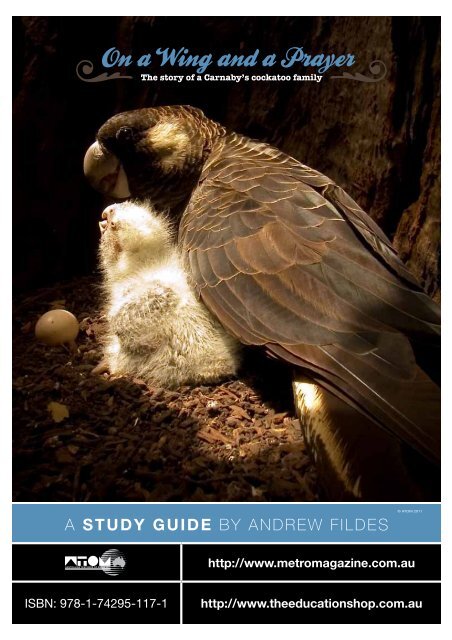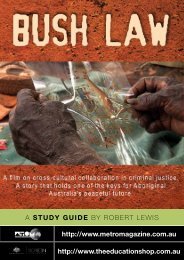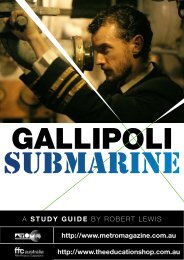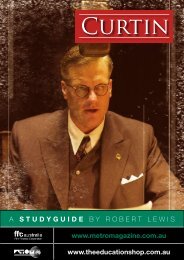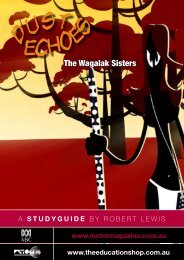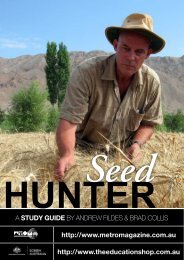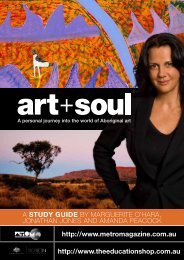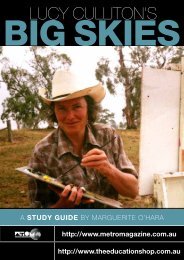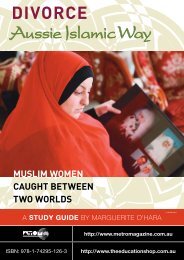On a Wing and a Prayer - ABC Commercial
On a Wing and a Prayer - ABC Commercial
On a Wing and a Prayer - ABC Commercial
- No tags were found...
Create successful ePaper yourself
Turn your PDF publications into a flip-book with our unique Google optimized e-Paper software.
<strong>On</strong> a <strong>Wing</strong> <strong>and</strong> a <strong>Prayer</strong>The story of a Carnaby’s cockatoo familyA STUDY GUIDE BY ANDREW FILDES© ATOM 2011http://www.metromagazine.com.auISBN: 978-1-74295-117-1http://www.theeducationshop.com.au
52 minutesSea Dog TV International Pty. LtdProducers:Jodie <strong>and</strong> Leighton De BarrosDirectors:Leighton De Barros & Samantha SmithWriters:Leighton De Barros & Samantha SmithCinematographer:Leighton De BarrosNarrator:William McInnesAcknowledgementDr Denis Saunders of CSIRO has been studying Carnaby’scockatoos from 1968 to 2011. The producers of <strong>On</strong> A <strong>Wing</strong><strong>and</strong> a <strong>Prayer</strong> would like to acknowledge <strong>and</strong> thank him forhis contribution of this knowledge <strong>and</strong> information to thefilm <strong>and</strong> this study guide. The producers would also like tothank the Department of Environment <strong>and</strong> Conservation’sRick Dawson, David Mell <strong>and</strong> Zoran Jovanovic fortheir contribution to the film <strong>and</strong> this study guide.Curriculum relevance:Environmental Studies/Science – endangeredspecies management <strong>and</strong> recovery.Science/Biology – breeding <strong>and</strong> habitatrequirements, human impact.Humanities – Social Science (social conflict). Geography.Media Studies – Wildlife documentary.Age appropriate: mid-primary to secondary.Executive producer:Dione GilmourSCREEN EDUCATION © ATOM 20112
IntroductionThe loss of any species is a tragedy, but when thatspecies is as fascinating <strong>and</strong> engaging as a cockatoo,the pain seems worse. We have a special love ofbirds <strong>and</strong> still feel the pain of losing the Dodo! Someof Australia’s five species of black cockatoo are introuble, but Carnaby’s cockatoo, endemic to the southwestof Western Australia is under particular pressurefrom human activities. This documentary examinesthe desperate situation of this remarkable animal.Like any cockatoo, Carnaby’s cockatoo has somethinguniquely Australian about it. Rowdy, raucous, intelligent<strong>and</strong> fun-loving, its haunting call has been part of theWestern Australian l<strong>and</strong>scape for the whole of humanexistence. <strong>On</strong>ce, thous<strong>and</strong>s of these birds darkenedthe sky as they foraged in their non-breeding areas.The timing of their movements from the non-breedingareas to the breeding areas in winter has led to thembeing regarded as harbingers of rain, or ‘rain birds’.Now they are sadly reduced to a fraction of their originalnumbers. Total numbers have halved in the last fortyyears. Because they are such a long-lived species,living for 25–50 years, it is thought that many of themcould now be elderly with few young birds in thepopulation. At present, there may be few young Carnaby’scockatoo being recruited to the breeding population.This documentary focuses on one family of Carnaby’scockatoo, a life-bonded pair whose ability to breedsuccessfully is important for the species. Each season,an experienced pair usually lays two eggs <strong>and</strong> mostcommonly raises one nestling, although they canoccasionally raise two. The birds are assisted bymany people, including scientists, farmers, membersof L<strong>and</strong>care groups, non-government conservationorganisations <strong>and</strong> government agencies. Rick Dawson,a senior wildlife officer of the Department of Environment<strong>and</strong> Conservation, is such a person. Rick has beenmonitoring nesting progress, protecting nests frompoachers, investigating <strong>and</strong> prosecuting people whoillegally kill protected fauna, <strong>and</strong> b<strong>and</strong>ing, micro-chipping<strong>and</strong> sampling DNA of nestling birds <strong>and</strong> assessingthe health of Carnaby’s cockatoo populations.Through this documentary, we get a fascinating glimpseof the life of this remarkable species <strong>and</strong> some of thepeople entrusted with its protection. Carnaby’s cockatoois an ideal species for classroom study as it has hugestudent appeal, specific dietary <strong>and</strong> breeding requirements<strong>and</strong> is listed as endangered by the Western AustralianGovernment, the Federal Government <strong>and</strong> internationally.Consequently it is important to examine, assess <strong>and</strong> learnmore about this signature species. The threats to wildCarnaby’s cockatoo are many. Some are still illegally shotby orchardists, trying to protect their crops. Others meettheir fate on the roads or are poached by thieves supplyingthe aviary trade; black cockatoos are keenly sought byoverseas bird keepers. But the biggest challenge they faceis the result of the loss <strong>and</strong> fragmentation of their habitat.Their breeding range is the highly productive Wheatbelt <strong>and</strong>much of their feeding shrub l<strong>and</strong>s <strong>and</strong> breeding trees havebeen cleared to grow crops. Areas outside their breedingareas have also been cleared for development, reducingnative food resources so the birds have to depend on theseeds of introduced plants in their non-breeding areas.SCREEN EDUCATION © ATOM 20113
CastCalyptorhynchuslatirostris – Carnaby’scockatoo or shortbilledblack-cockatoo.Carnaby’s cockatoo is endemic to south-westernAustralia <strong>and</strong> is one of five black cockatoo species foundin Australia, <strong>and</strong> one of three in WA. It is a large bird,53–58cm long, weighing between 500 to 800 grams withwhite-b<strong>and</strong>ed tail feathers. Adult males have black bills,red eye rings <strong>and</strong> smallish, dirty white cheek patches.Adult females have bone coloured bills <strong>and</strong> large cleanwhite cheek patches. They do not breed until they areat least four years old <strong>and</strong> may live for between twentyfive<strong>and</strong> fifty years in the wild, in ideal conditions.Carnaby’s cockatoo breeds in the woodl<strong>and</strong>s of thesemi-arid interior of south-western Australia from Julyto December, <strong>and</strong> migrates to coastal areas during thenon-breeding season – following food sources. It feedson the seeds of native shrubs <strong>and</strong> trees <strong>and</strong> introducedpine trees as well as wood-boring insect grubs.Extensive historic clearing of the woodl<strong>and</strong>s <strong>and</strong>kwongan (shrubl<strong>and</strong>s) for broad scale agriculture hasreduced the range <strong>and</strong> abundance of the species,reducing the number of available tree hollows <strong>and</strong> nearbyfood species. Unlike some cockatoos, they do not eatwheat seed. They are also threatened in their summerfeeding <strong>and</strong> roosting grounds by direct human impactssuch as clearing of feeding <strong>and</strong> roosting vegetation,collisions with motor vehicles, poachers <strong>and</strong> orchardistsshooting them to keep them away from crops.Rick Dawson, SeniorInvestigator, Dept.of Environment <strong>and</strong>ConservationRick is a senior wildlife officer in Western Australia withresponsibility for investigations <strong>and</strong> operations on l<strong>and</strong> <strong>and</strong>sea throughout the state. His responsibilities are as variedas regulating the harvesting of aromatic S<strong>and</strong>alwood trees<strong>and</strong> participating in a team which disentangles large whalesfrom fishing gear during the whale migration season.He specialises in the protection of WA’s threatenedblack cockatoos, which include Carnaby’s, Baudin’s,<strong>and</strong> the Forest red-tailed black cockatoos. Populationshave to be monitored for numbers <strong>and</strong> health; nestingsites maintained <strong>and</strong> protected; sick <strong>and</strong> injured birdsor ‘derelicts’ have to be rescued <strong>and</strong> returned to thewild if possible; research programs involving DNA‘fingerprinting’ <strong>and</strong> microchipping are carried out; <strong>and</strong>the captive breeding program has to be administered.SCREEN EDUCATION © ATOM 20114
ViewingquestionsDuring viewing, the following questionscould be considered:» Why does the documentary begin in a cemetery?» What is the origin of the title, ‘<strong>On</strong> a <strong>Wing</strong> <strong>and</strong> a <strong>Prayer</strong>’?» Why do the Carnaby’s cockatoos feedalong the coastal strip in summer?» What do they feed on?» Why do they preen each other? Howlong do couples stay together?» When do they leave the coast for the breeding grounds?» Why would an orchard grower shootcockatoos? What can they do instead?» What is the other, related, black cockatoo?» Why is evidence of rifle use important?» How many birds appear to have been shotfrom the evidence presented in film?» What has happened to the nestinggrounds in recent years?» How old does a Eucalypt tree have to be to have hollowsthat are ideal for Carnaby’s cockatoo to breed?» Why do poachers target the black cockatoos?» How does a cockatoo choose a nesthollow – what are the requirements?» Which other cockatoo species are doingbetter in the agricultural regions?» What is the role of the male birdduring egg incubation? Why?» Why does the female roll the eggs?How often does she do it?» What may have made the rescued cockatoos sick?» Where does the vet work? What is the treatment?» Why does the female have to leaveher chick for long periods?» Why did the second chick die?» Which non-native tree has thecockatoo learned to feed on?» What surprises does Rick find in thetree hollows he checks?» How many rescued birds are released? Who helps?» What encourages the mature chick toleave the tree hollow <strong>and</strong> fly?» Birds don’t have shopping bags! How docockatoos carry food to each other?SCREEN EDUCATION © ATOM 20115
Tasks <strong>and</strong> extension activities1. CREATE A FLOCK OF COCKIES.Based on freeze frames from the documentary, drawcockies in flight on A4 sheets of paper, colour themblack with white tail patches <strong>and</strong> cut them out. Stickthem on the classroom wall – protect your flock!http://australianmuseum.net.au/image/Flying-Yellow-tailed-Black-cockatoo2. COCKATOOS AS PETS:Several species of cockatoos are kept as pets.They are dem<strong>and</strong>ing <strong>and</strong> long-lived, not to betaken into the family lightly. But they are bright,intelligent, humorous <strong>and</strong> easy to tame.Which species of cockatoo are commonly keptas pets? What are their special requirements?Are black cockatoos kept as pets at all? Would alicence be required if you wanted to keep one?3. WHAT ARE THE SPECIFIC THREATS TO THECARNABY’S COCKATOO HABITAT?Prepare a report on the habitats required by thebird <strong>and</strong> the human impact on both the winterbreeding grounds <strong>and</strong> summer feeding grounds.Are these impacts more significant than otherthreats like cars, poachers <strong>and</strong> shooters?4. FRAGMENTATION:The development of wheat l<strong>and</strong>s in WA has causedfragmentation of the nesting areas of the cockatoos.The available sites have been broken up into ‘isl<strong>and</strong>s’with little food available nearby. This is a typicalsurvival problem for native species in all parts of theworld. Prepare a PowerPoint presentation or poster onthe problem of habitat fragmentation, with referenceto terms like ‘isl<strong>and</strong>s’ <strong>and</strong> ‘corridors’. Explain whythe conservation of species in isolated fragments ofnatural environment is difficult <strong>and</strong> often impossible.http://en.wikipedia.org/wiki/Habitat_fragmentation5. WHAT ARE THE RESPONSIBILITIES OF AWILDLIFE OFFICER LIKE RICK DAWSON?WHAT POWERS DOES A WILDLIFE OFFICERLIKE RICK HAVE? IF HE CAUGHT THESHOOTERS, WHAT COULD HE DO?http://www.austlii.edu.au/au/legis/wa/consol_act/wca1950236/s20.htmlRick has a background in the defence forces ratherthan an academic background. What are the usualrequirements for a career as a wildlife officer? Investigatethe requirements in your school’s careers room withparticular reference to your state. What would you needto do to work in the area of wildlife conservation?6. Some of the rescued cockatoos develop ‘parrotfever’ or psittacosis, a form of chlamydia. This is aserious disease that is zoonotic – meaning it canaffect humans as well as other animals. It is oneof the reasons that international trade in parrots isseverely restricted. Investigate <strong>and</strong> report on thedisease, including other forms of chlamydia thataffect humans <strong>and</strong> animals, such as the Koala.http://en.wikipedia.org/wiki/Psittacosis7. WHY DO POACHERS TARGET COCKATOOS AND STEALTHEIR EGGS TO SMUGGLE OUT OF AUSTRALIA?Australia does not permit the export of live nativemammals, amphibians, reptiles or birds for commercialpurposes. This includes cockatoos. Cockatoos can beworth thous<strong>and</strong>s of dollars in Asia or the USA. Thereis a huge illegal trade in live birds <strong>and</strong> fertile eggs.The trade in vulnerable species like Carnaby’scockatoo is regulated by CITES – the Convention onInternational Trade in Endangered Species. Australiahas been a signatory to this global agreementsince 1976, although many countries are not. Thedetails are available at .Prepare a report on how CITES works. Identify someof the signature species from the CITES list. How longhas each been protected? Also investigate some ofthe less common species, animals <strong>and</strong> plants that areunknown to you. Are some plants, such as orchids atparticular risk from illegal international trafficking?SCREEN EDUCATION © ATOM 20116
Environmental StudiesExtension resourcesThere are a number of developed resources onlinefor extended study of the Carnaby’s cockatoo atvarious year levels. Here are three with suitableguide <strong>and</strong> comprehension questions.Juniorhttp://atom.asn.au/wing_<strong>and</strong>_a_prayer/australian_threatened_species.pdf» What is the other common name forthe Carnaby’s cockatoo?» What are their exact breeding requirements?» What is their diet?» Why are their numbers likely to crashin the next few years?» What are the threats to the Carnaby’scockatoo? Make a summary list.» What strategies can be used to protectthe bird <strong>and</strong> its nesting habitat?IntermediateAUSTRALIAN ASSOCIATION FORENVIRONMENTAL EDUCATIONBUGS, BEAST AND BIODIVERSITYCASE STUDY 4 – VANISHING CARNABY’S COCKATOOSSUITABLE FOR GRADE 6 TO YEAR 10http://atom.asn.au/wing_<strong>and</strong>_a_prayer/vanishing_carnaby_cockatoos.pdfThis is designed for students living within the range ofthe Carnaby’s or short-billed black-cockatoo but canbe modified easily for use by students anywhere.E1 Web of Life» Black cockatoos are often seen as destructivebecause they damage plants <strong>and</strong> trees.What are the cockatoos searching for?» They are part of an ecosystem that involves other plants<strong>and</strong> animals. What are these other species <strong>and</strong> what arethe relationships between them <strong>and</strong> Carnaby’s cockatoo?E1–2 What Do We Know?» How has the overall population of Carnaby’scockatoo been reduced <strong>and</strong> why?» What similarities <strong>and</strong> differences are there betweenCarnaby’s cockatoo <strong>and</strong> Baudin’s cockatoo?» Why are the different Aboriginal namesfor the bird all a bit similar?E3 Diet» Why is the cockatoo NOT a vegetarian?» Why is the damage to the banksiaplants NOT a problem?» What introduced plant do these cockatoos eat <strong>and</strong> why?E3 Distribution <strong>and</strong> Habitat» What does the Carnaby’s cockatoorequire to feed <strong>and</strong> breed?» Why do the cockatoos migrate every year?» Why do you think they lay a second eggif the second chick usually dies?SCREEN EDUCATION © ATOM 20117
E4 What Happened? A Vanishing Habitat» Why has the cockatoo stopped breeding in many areas?» What species have done better in the wheatbelt – why?» What other threats are there as aresult of farming practices?» What direct human impacts are there on the cockatoo?» Which other cockatoos have suffered fromthe same practices <strong>and</strong> impacts?E7 – Activities» The picture book <strong>and</strong> board game activities areappropriate for junior students. Students might alsocreate web pages, posters or PowerPoint presentationsfor Carnaby’s cockatoo or for a similar local species.SeniorThere is a quite short <strong>and</strong> straightforward recovery plan,which senior Environmental Studies <strong>and</strong> Science studentscan read <strong>and</strong> assess to underst<strong>and</strong> what a typicalgovernment plan for an endangered species has to provide.Download the 2003 recovery plan at or go to <strong>and</strong>search for Carnaby’s cockatoo recovery plan.This will bring up the 2002–2012 plan by Belinda Cale.QUESTIONS» You may be required to prepare a recovery plan for anendangered species as part of your course requirements.This is an actual recovery plan commissioned bythe Western Australian government for Carnaby’scockatoo. Look at the general outline of the plan.What is the structure of this report/plan? What doesthe introduction do <strong>and</strong> what sections follow it?SUMMARY – P.7» Where does the bird live <strong>and</strong> what are its precisehabitat requirements for breeding <strong>and</strong> feeding?» What are the success <strong>and</strong> failure criteria for theplan? Can you apply this succeed/fail approach toother processes – your own studies perhaps?» What does the summary suggest is the mostappropriate approach to protection <strong>and</strong> recovery<strong>and</strong> why? What is the projected cost?INTRODUCTION – PP. 8–18.1.1: Description.» The Carnaby’s (or Short-billed) cockatoo is one of fiveCalyptorhynchus or ‘dark’ cockatoo species. Whatare the others? How many of them are endangered?See .1.2: Distribution» Map the range of the Carnaby’s cockatoo on a map ofWestern Australia. Suggest why they may use differentareas for breeding season to the rest of the year.SCREEN EDUCATION © ATOM 20118
1.3: Habitat» What are the specific features of this habitatthat they require for feeding <strong>and</strong> breeding?1.3.1: Hollow requirements1.6: Existing conservation measures» What is the ‘derelict’ program <strong>and</strong> why is it so valuable?» What are the procedures for thecaptive breeding program?» What species of tree does the bird prefer to nest in?What size of nesting hollow does it require? What arethe causes of nesting hollow loss for the cockatoo?» Based on the details here <strong>and</strong> the nests you’ve seen inthe film, design a nest box that would suit this bird.1.4: Life history <strong>and</strong> ecology» Movements: What does ‘gregarious’ mean <strong>and</strong>how does this describe their behaviour?» Diet: What does ‘arboreal’ mean? What are the majorcomponents of Carnaby’s cockatoo’s original diet?What has it added since European settlement?» Reproduction: Fledgling success is defined by a pairraising one chick during a season. What is the successrate for the two areas studied? What accounts for thesignificant difference? What is the cause of this problem?» Survival: What are the survival rates foradults <strong>and</strong> juveniles? What is the majorpredator of Carnaby’s cockatoo?1.5: Reasons for listing» Why has the cockatoo been listed as endangered?What are the basic criteria for this ranking?» Prepare a poster or PowerPoint demonstratingthe human impacts on the Carnaby’s cockatoopopulation <strong>and</strong> the resulting endangered status.» What programs have students beeninvolved in? How does this help?1.7: Strategy for recovery» Why is habitat management the highestpriority for protecting the bird?» Summarise the management actions recommendedfor the breeding <strong>and</strong> non-breeding zones.ACTIONS – PP. 18–252: Objectives» What are the success criteria for this plan <strong>and</strong> program?3: Critical Habitat» What are the three critical habitatsfor the cockatoo? Why?5: Actions» Summarise the actions required by the plan forprotecting <strong>and</strong> recovering the cockatoo.» Which are the most expensive actions <strong>and</strong> why?An alternative <strong>and</strong> more recent field study can be found at.It is prepared by Birds Australia, a non-governmentorganisation, <strong>and</strong> includes distribution maps.SCREEN EDUCATION © ATOM 20119
This study guide was produced by ATOM. (© ATOM 2011)ISBN: 978-1-74295-117-1 editor@atom.org.auFor more information on SCREEN EDUCATION magazine,or to download other study guides for assessment,visit .Join ATOM’s email broadcast list for invitations tofree screenings, conferences, seminars, etc.Sign up now at .For hundreds of articles on Film as Text,Screen Literacy, Multiliteracy <strong>and</strong> Media Studies,visit .


